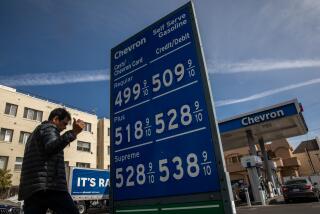Crude Prices Get Closer to $45
- Share via
Unrest in Iraq and elsewhere lifted crude oil prices to a record high near $45 a barrel Monday, yet gasoline prices in California and across the country fell for the 10th consecutive week.
The divergence reflected an all-out push this summer by domestic refiners to produce as much gasoline as possible, which has raised inventories and pushed retail prices down.
Still, the average price for a gallon of self-service regular in California is 35% more than it was a year ago. And crude prices have soared $12.32 a barrel, or 38%, this year.
They moved up Monday after Iraq stopped pumping oil to key southern terminals on the Persian Gulf after followers of the Shiite cleric Muqtada Sadr threatened to attack pipelines.
“Every day it’s something new,” said Bruce Schwartz, an analyst at Standard & Poor’s Corp. in New York. With global demand so high and supplies so tight, “the market is prone to move in an exaggerated fashion with each new development.”
Oil for current delivery on the New York Mercantile Exchange briefly touched $44.97 per 42-gallon barrel before closing at $44.84, up 89 cents, or 2%, for the day. It was the highest close since oil futures contracts began trading on the exchange 21 years ago.
At the pump, the average price for regular gasoline in California slipped 3.6 cents, to $2.092 a gallon, in the week ended Monday, the Energy Department’s Energy Information Administration said in its weekly survey.
Gasoline prices have fallen steadily in California since they hit a record $2.327 a gallon in late May.
The nationwide average also fell in the week, by 1.1 cents to $1.877 a gallon, though it remains 31 cents higher than it was a year ago.
Iraq wasn’t the only trouble spot on oil traders’ minds Monday. There also were fears of terrorism in oil-rich Venezuela as Sunday’s recall vote on President Hugo Chavez approaches; Venezuela’s state oil company said it was boosting security at its facilities.
In addition, the beleaguered Russian oil company Yukos suffered new setbacks, reigniting the markets’ fear of a break in its supplies. Government authorities renewed their seizure of Yukos’ assets to collect on the company’s massive tax bill, a move Yukos said could force it into bankruptcy protection and halt its production.
If a supply shortage were to develop, some analysts fear the Organization of the Petroleum Exporting Countries and other major producers wouldn’t be able to pump enough to fill the gap.
“There’s not that much spare capacity in the market right now to offset the loss,” said Jacques Rousseau, an analyst with the investment firm Friedman, Billings, Ramsey & Co. in Arlington, Va.
A lengthy disruption that removed 500,000 to 750,000 barrels a day from the market could send crude oil prices to $50 a barrel, said Daniel Yergin, an industry historian and chairman of the consulting firm Cambridge Energy Research Associates.
“The world has one of the smallest cushions ever for absorbing a loss of supply, while demand growth is the strongest in a generation,” Yergin said in a note to clients Monday.
Lofty oil prices already are causing problems for the Federal Reserve Board as the central bank tries to plumb the negative effect on the U.S. economy. On Friday, the Labor Department reported that job growth in July slowed to a near standstill, indicating that oil prices were impeding the economy’s expansion.
The Federal Reserve’s policymaking arm meets today and is expected to nudge its benchmark short-term interest rate to 1.5% from 1.25%. The Fed was expected to tighten credit further in the months ahead to avoid an overheated economy and higher inflation, but now some economists wonder whether those plans will be put on hold.
*
Times wire services were used in compiling this report.
More to Read
Inside the business of entertainment
The Wide Shot brings you news, analysis and insights on everything from streaming wars to production — and what it all means for the future.
You may occasionally receive promotional content from the Los Angeles Times.











